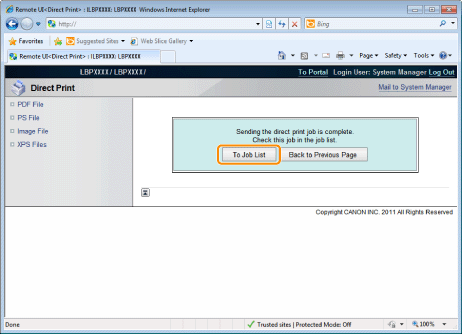Printing the PDF File Using the Direct Print Function
1
Start the Remote UI.
2
Select [PDF File] from the [Direct Print] menu.
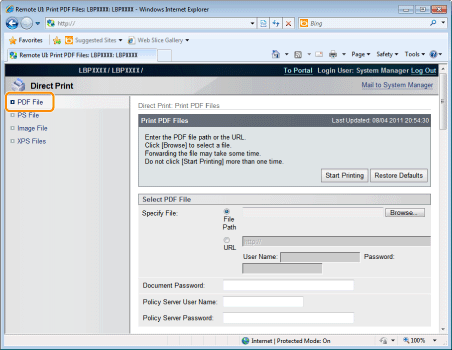
3
Specify [Select PDF File].
When specifying [File Path]
Click [Browse...], select the file, and then click [Open...].
When specifying [URL]
Enter the URL of the PDF file that you want to print.
 |
If you specify a URL that requires user authentication, enter [User Name] and [Password].
|
 |
When specifying a URL and printing, the next print job cannot be performed until the PDF is finished downloading or the connection with the Web server is terminated.
|
 |
The protocol for specifying a URL and printing only supports HTTP.
|

4
Enter the password in [Document Password] when a password is specified for opening the document or when it is necessary to enter a password to print.
 |
If printing is attempted without entering a password, <Cannot decode PDF data.> is displayed, and printing is cancelled. When printing PDF files with settings that do not allow them to be printed or when printing in high resolution PDF files with settings that only allow them to be printed in low resolution, enter the master password.
|
 |
When you print a PDF file linked to a policy server, enter [Policy Server User Name] and [Policy Server Password].
|
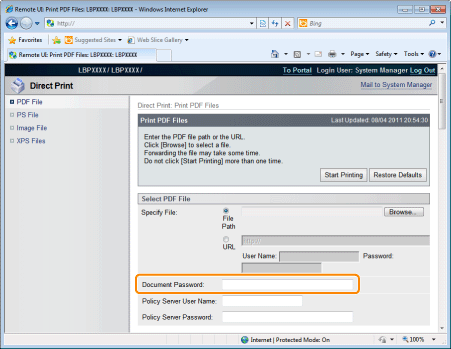
5
Specify the setting for [Specify Print Range].
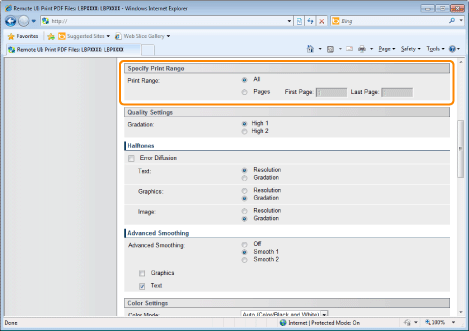
|
[All]
|
Select if you want to print all the pages.
|
|
[Pages]
|
Select [Pages], and then enter the starting page number and ending page number if you want to specify the print range.
|
6
Specify the settings for [Quality Settings] as the following, as needed.
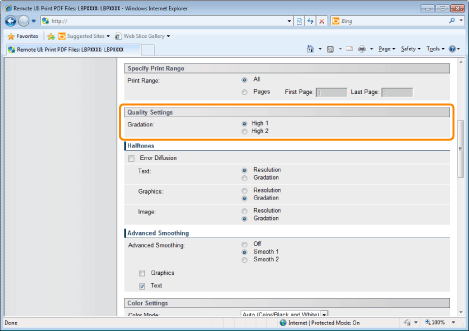
|
[Gradation]
|
Specify the gradation process for printing the data. It is effective to set [High 1] when printing photographs at standard quality, and to set [High 2] when printing at a higher quality.
|
7
Specify the settings for [Halftones] as the following, as needed.
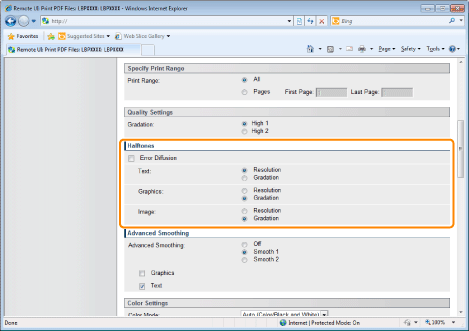
|
[Halftones]
|
Specify the halftone display method when printing.
When [Error Diffusion] is selected, it is possible to print at a higher resolution than [Resolution], but texture stability is slightly inferior. It is suitable for printing data containing text and fine lines and data such as CAD data that is printed with sharp edges.
When [Error Diffusion] is not selected, it is possible to select the halftone display method from [Resolution] or [Gradation] for [Text], [Graphics] or [Image].
|
8
Specify the settings for [Advanced Smoothing] as the following, as needed.
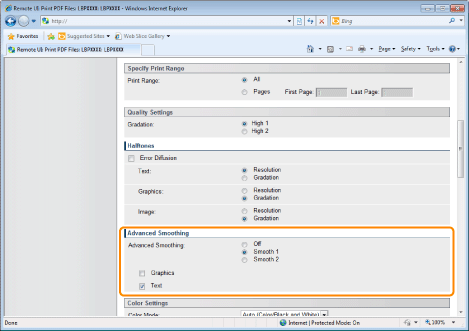
|
[Advanced Smoothing]
|
Specify whether to use the smoothing process to smooth the edges of graphics (illustrations created in other applications) or text. [Smooth 2] is better than [Smooth 1] for performing a smoothing process that provides more smoothing. First, set it to [Smooth 1], and if the data is still not smooth, set it to [Smooth 2].
In addition, by selecting [Graphics] and [Text], you can select what to smooth.
This item specifies the smoothing process for graphics data and text data. Image data cannot be specified.
[Graphics] and [Text] settings on the printer console are suitable only when [Advanced Smoothing] on the printer driver is set to [Printer Default].
The effects of advanced smoothing differ depending on the pattern of the text or the graphics.
|
9
Specify the settings for [Color Settings] as the following, as needed.
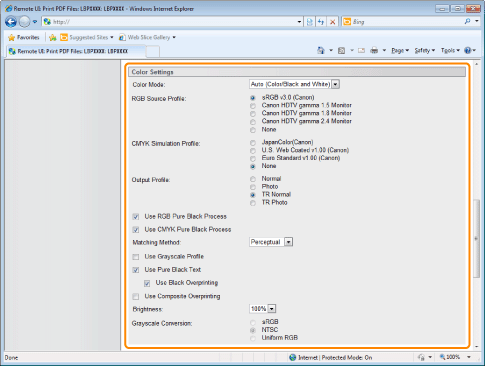
|
[Color Mode]
|
Specify color printing or B&W printing.
|
||||||||
|
[RGB Source Profile]
|
You can select an RGB profile that is suitable for the features of the monitor that you are using. Set it when printing images drawn with an RGB color model or documents that contain images.
|
||||||||
|
[CMYK Simulation Profile]
|
You can set a simulation target when printing CMYK data. The machine converts CMYK data to a device-dependent CMYK color model in accordance with the simulation target selected by the CMYK simulation profile.
|
||||||||
|
[Output Profile]
|
You can define suitable profiles for data that you are trying to print.
|
||||||||
|
[Use RGB Pure Black Process]
|
When device-dependent RGB data is converted to device-dependent CMYK using [RGB Source Profile] in this machine, set what type of processing to use for black and gray data that becomes R=G=B.
If uneven gradation or staining is visible when printing black or gray data, do not set this item. Set [Output Profile] to [Normal].
If this item is not set, a combination of settings enable gray data (C=M=Y=0 color) to be printed using black (Bk) toner. An example is shown below.
If [Use Pure Black Text] is selected
When [RGB Source Profile] is set as [None]
When [Output Profile] is set as [TR Normal] or [TR Photo]
When the printer driver's [Use 100% GCR Profile] is enabled
If [RGB Source Profile] is set as [None], the setting for this item becomes invalid.
|
||||||||
|
[Use CMYK Pure Black Process]
|
When device-dependent CMYK is processed using [CMYK Simulation Profile] in this machine, set what type of printing to use for grey data (C=M=Y=0).
Even if this item is not selected, a combination of settings enable grey data (C=M=Y=0 color) to be printed using black (Bk) toner, as shown below. An example is shown below.
If [Use Pure Black Text] is selected
If [CMYK Simulation Profile] is set as [None]
When [Output Profile] is set as [TR Normal] or [TR Photo]
When the printer driver's [Use 100% GCR Profile] is enabled
If [CMYK Simulation Profile] is set as [None], the setting for this item becomes invalid.
|
||||||||
|
[Matching Method]
|
Specify the printing method when [RGB Source Profile] is applied. You can select color rendering style on the machine, as shown below.
|
||||||||
|
[Use Grayscale Profile]
|
You can use this machine's grayscale profile to convert device-dependent grey data to CMYK data. However, it may be reproduced using black (Bk) toner only, by using the [Output Profile] or [Use Pure Black Text] settings.
|
||||||||
|
[Use Pure Black Text]
|
You can print data for black colors created by applications using only 100% black toner. Since monochrome (black) toner only is used for black text, there is never the problem of color toner slurring around the edges of the characters.
|
||||||||
|
[Use Black Overprinting]
|
If the check box for this option is selected, the printer prints black text over a color background. If this option is used with [Use Pure Black Text], the printer prints all the background first, and then prints the text over the color background using only the black (Bk) toner. This alleviates the phenomenon in which the outlines of the printed black text are rimmed with white.
|
||||||||
|
[Use Composite Overprinting]
|
You can overprint device-dependent CMYK data as composite output. Since all the colors used in the data are overprinted to a single palette, you can check the result without performing color separation.
|
||||||||
|
[Brightness]
|
You can adjust the brightness of the whole image. You can use this item to set from 85% to115% at intervals of 5%. The smaller the value the brighter it becomes. The larger the value the darker it becomes.
|
||||||||
|
[Grayscale Conversion]
|
Select the method for converting color print data to grayscale for printing.
This setting is for converting color data to B&W data.
The setting for this item becomes invalid for B&W data.
If [Color Mode] is set as [Auto (Color/Black and White)], the setting for this item becomes invalid.
|
10
Specify the settings for [Print Settings] as the following, as needed.
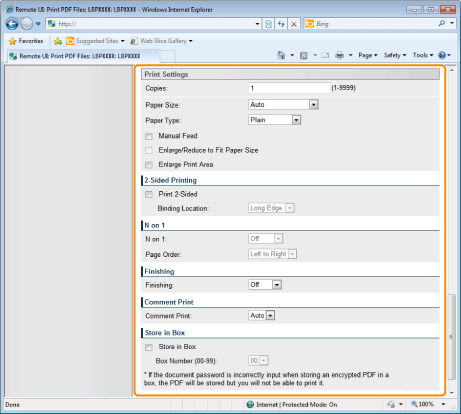
|
[Copies]
|
Specify the number of copies to be printed.
|
||||
|
[Paper Size]
|
Specify the size of paper to print.
If data is input that is outside the engine's maximum and minimum paper size range when the paper size is automatic, it is printed on the paper size that is set with [Standard Paper Size].
|
||||
|
[Paper Type]
|
Specify the type of paper to print.
|
||||
|
[Manual Feed]
|
You can fix the paper source in the multi-purpose tray.
|
||||
|
[Enlarge/Reduce to Fit Paper Size]
|
If the check box is selected, it fixes the aspect ratio and scales it to fit with the effective print area of the paper size that is set and prints. However if [Paper Size] is set as [Auto], this item cannot be set.
|
||||
|
[Enlarge Print Area]
|
Specify whether to expand the printable area and print.
Depending on the document to be printed, part of the edges of the paper may not be printed.
|
||||
|
[Print 2-Sided]
|
Specify 1-sided or 2-sided printing.
|
||||
|
[Binding Location]
|
Set the binding position on the long side of the paper (long-edged binding) or the short side of the paper (short-edged binding). If binding is set from the printer side, the position of the "gutter" is automatically adjusted on the front and back sides of the paper.
|
||||
|
[N on 1]
|
You can print multiple pages of the PDF file data arranged on one page.
When printing multiple pages side by side, set [Paper Size] to a setting other than [Auto].
|
||||
|
[Page Order]
|
The [N on 1] setting enables you to set the order the pages will be arranged on the paper when printing multiple pages on one page.
|
||||
|
[Finishing]
|
(It is only displayed when an SD card is used.)
It collates and prints in page or section units.
|
||||
|
[Comment Print]
|
Specify whether to print the notes of PDF files.
|
||||
|
[Store in Box]
|
(It is only displayed when an SD card is used.)
When storing it in a box, check the [Store in Box] check box before selecting the box where you want to store it.
|
11
Click [Start Printing].
 |
Do not keep clicking [Start Printing] while the file is transferring. Sometimes it takes time to transfer a file, but if you keep clicking during the transfer, a file failure may occur and it may be impossible to transfer it.
|
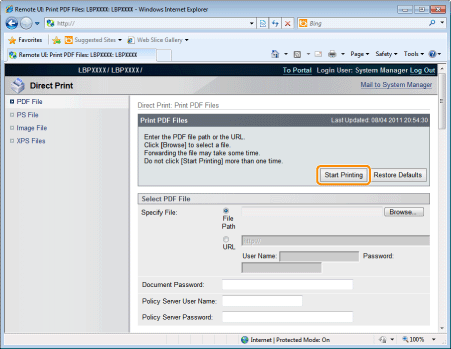
|
→
|
When the print job has finished sending, the display switches and the following message is displayed.
|
 Press [To Job List] to check the print job that was sent.
|
